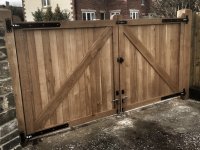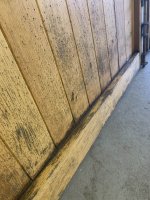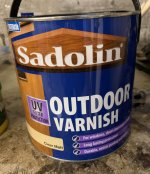woodbutcherbower
Member
I recently posted this as a reply comment to a topic in 'Member Projects' - but I decided that it was important enough to start a new topic, since you won't have seen my post unless you were looking at that particular topic.
So ........
A serious word of warning to anyone who is maybe planning to protect exterior hardwood work with Osmo 420 UV protection oil. The formulation was changed awhile ago, apparently to meet a new set of European solvent and environmental regulations. They didn't make any kind of announcement about this - they just did it. The net result is that it’s now no longer suitable for ANYTHING which isn’t vertical - so that means doorsteps, window sills, the top rails of gates and balustrades, the flat surfaces of outdoor furniture - even the small horizontal framing lips on doors, gates and similar. They've changed the application instructions on the can accordingly, but of course guys like me (who have been using the product for many years) don't take time out to read the instructions when they're opening maybe their 50th or 60th 2.5-litre can of what appears to be an absolutely identical product.
In the last six months, I’ve had to revisit customers to strip and refinish seven exterior jobs (including the £6,000 set of kiln-dried oak driveway gates pictured - the first one shows the gates when I'd just finished installing them, the other picture shows the same gates just 18 months later) where the 420 had failed catastrophically on horizontal surfaces as soon as it got wet. After the amount of work which goes into things like this, it's heartbreaking to see. The product also partially failed on the vertical surfaces - which Osmo are still claiming it's suitable for. This whole debacle has cost me heavily, as I always look after my customers and I'll always do the right thing, but Osmo don't want to know. Their best offer was just to refund the cost of the can after I'd shouted loudly enough [sad]
Just a important heads-up for you, especially if you live in the colder, wetter states.
Kevin
[attachimg=1]
[attachimg=2]
So ........
A serious word of warning to anyone who is maybe planning to protect exterior hardwood work with Osmo 420 UV protection oil. The formulation was changed awhile ago, apparently to meet a new set of European solvent and environmental regulations. They didn't make any kind of announcement about this - they just did it. The net result is that it’s now no longer suitable for ANYTHING which isn’t vertical - so that means doorsteps, window sills, the top rails of gates and balustrades, the flat surfaces of outdoor furniture - even the small horizontal framing lips on doors, gates and similar. They've changed the application instructions on the can accordingly, but of course guys like me (who have been using the product for many years) don't take time out to read the instructions when they're opening maybe their 50th or 60th 2.5-litre can of what appears to be an absolutely identical product.
In the last six months, I’ve had to revisit customers to strip and refinish seven exterior jobs (including the £6,000 set of kiln-dried oak driveway gates pictured - the first one shows the gates when I'd just finished installing them, the other picture shows the same gates just 18 months later) where the 420 had failed catastrophically on horizontal surfaces as soon as it got wet. After the amount of work which goes into things like this, it's heartbreaking to see. The product also partially failed on the vertical surfaces - which Osmo are still claiming it's suitable for. This whole debacle has cost me heavily, as I always look after my customers and I'll always do the right thing, but Osmo don't want to know. Their best offer was just to refund the cost of the can after I'd shouted loudly enough [sad]
Just a important heads-up for you, especially if you live in the colder, wetter states.
Kevin
[attachimg=1]
[attachimg=2]




